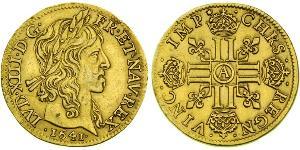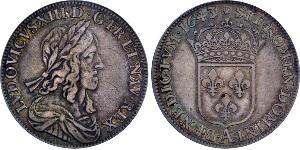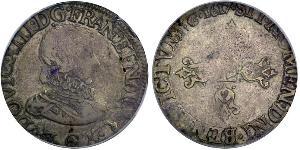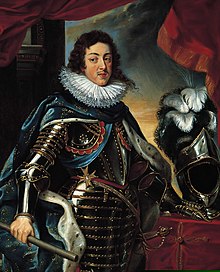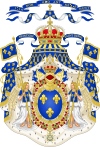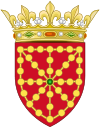| This article needs additional citations for verification. (October 2012) |
| Louis XIII | |
|---|---|
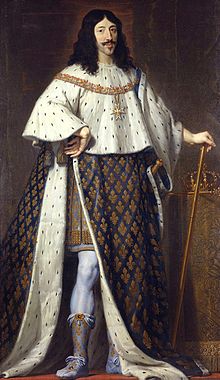 |
|
| King of France and Navarre | |
| Reign | 14 May 1610 – 14 May 1643 |
| Coronation | 17 October 1610 |
| Predecessor | Henry IV and III |
| Successor | Louis XIV |
| Regent | Marie de' Medici (1610–1614) |
| Spouse | Anne of Austria |
| Issue | Louis XIV of France Philippe I, Duke of Orléans |
| House | House of Bourbon |
| Father | Henry IV of France |
| Mother | Marie de' Medici |
| Born | 27 September 1601 Château de Fontainebleau, France |
| Died | 14 May 1643 (aged 41) Paris, France |
| Burial | Saint Denis Basilica, France |
| Religion | Roman Catholicism |
Louis XIII (27 September 1601 – 14 May 1643) was a monarch of the House of Bourbon who ruled as King of France from 1610 to 1643 and King of Navarre (as Louis II) from 1610 to 1620, when the crown of Navarre was merged to the French crown.
Louis succeeded his father Henry IV as king of France and Navarre a few months before his ninth birthday. His mother, Marie de' Medici, acted as regent during Louis's minority. Mismanagement of the kingdom and ceaseless political intrigues by Marie de' Medici and her Italian favourites led the young king to take power in 1617 by exiling his mother and executing her followers, including Concino Concini, the most influential Italian at the French court.
Louis XIII, taciturn and suspicious, relied heavily on his chief minister Cardinal Richelieu to govern the kingdom of France. King and cardinal are remembered for the establishment of the Académie française and for putting an end to the revolt of the French nobility. The reign of Louis "the Just" was also marked by the struggles against Huguenots and Habsburg Spain.[1]
France's greatest victory in the conflicts against the Habsburg Empire during the period 1635-59 came at the Battle of Rocroi (1643), five days after Louis's death from apparent complications of intestinal tuberculosis. This battle marked the end of Spain's military ascendancy in Europe and foreshadowed French dominance in Europe under Louis XIV, his son and successor.[2]
Contents
- 1 Early life, 1601–10
- 2 Rule of Marie de' Medici, 1610–17
- 3 Ascendancy of Charles de Luynes, 1617–21
- 4 Rule by Council, 1622–24
- 5 Ministry of Cardinal Richelieu, 1624–42
- 6 Death
- 7 Expansion overseas under Louis XIII
- 8 Relationships and issue
- 9 Composer and lute player
- 10 Impact on men's fashion
- 11 In fiction and film
- 12 Ancestors
- 13 See also
- 14 Notes
- 15 References
- 16 Further reading
- 17 External links
Early life, 1601–10[edit]
Born at the Château de Fontainebleau, Louis XIII was the oldest child of King Henry IV of France and his second wife Marie de' Medici. As son of the king, he was a Fils de France ("son of France"), and as the eldest son, Dauphin of France. His father Henry IV was the first French king of the House of Bourbon, having succeeded his ninth cousin, Henry III of France (1574–1589), in application of Salic law. Louis XIII's paternal grandparents were Antoine de Bourbon, duc de Vendôme, and Jeanne d'Albret, Queen of Navarre. His maternal grandparents were Francesco I de' Medici, Grand Duke of Tuscany, and Johanna, archduchess of Austria. Eleonora de' Medici, his maternal aunt, was his godmother.[3]
The ambassador of King James I of England to the court of France, Edward Herbert, 1st Baron Herbert of Cherbury, who presented his credentials to Louis XIII in 1619, remarked on Louis’s extreme congenital speech impediment and his double teeth:
...I presented to the King [Louis] a letter of credence from the King [James] my master: the king [Louis] assured me of a reciprocal affection to the king [James] my master, and of my particular welcome to his Court: his words were never many, as being so extream [sic] a stutterer that he would sometimes hold his tongue out of his mouth a good while before he could speak so much as one word; he had besides a double row of teeth, and was observed seldom or never to spit or blow his nose, or to sweat much, 'tho he were very laborious, and almost indefatigable in his exercises of hunting and hawking, to which he was much addicted...[4]
Rule of Marie de' Medici, 1610–17[edit]
Louis XIII ascended the throne in 1610 at the age of eight-and-a-half upon the assassination of his father. His mother Marie de' Medici acted as Regent until 1617. Although Louis XIII became of age at thirteen (1614), his mother did not give up her position as Regent until 1617. Marie maintained most of her husband's ministers, with the exception of Maximilien de Béthune, Duke of Sully, who was unpopular in the country. She mainly relied on Nicolas de Neufville, seigneur de Villeroy, Noël Brûlart de Sillery, and Pierre Jeannin for political advice. Marie pursued a moderate policy, confirming the Edict of Nantes. She was not, however, able to prevent rebellion by nobles such as Henri, Prince of Condé (1588–1646) second in line to the throne after Marie's second surviving son Gaston, Duke of Orléans. Condé squabbled with Marie in 1614, and briefly raised an army, but he found little support in the country, and Marie was able to raise her own army. Nevertheless, Marie agreed to call an Estates General assembly to address Condé's grievances.
The assembly of this Estates General was delayed until Louis XIII formally came of age on his thirteenth birthday. Although Louis's coming-of-age formally ended Marie's Regency, she remained the de facto ruler of France. The Estates General accomplished little, spending its time discussing the relationship of France to the Papacy and the venality of offices, but not reaching any resolutions.
Beginning in 1615, Marie came to rely increasingly on the Italian Concino Concini, who assumed the role of her favourite. Concini was widely unpopular because he was a foreigner. This further antagonised Condé, who launched another rebellion in 1616. Huguenot leaders supported Condé's rebellion, which led the young Louis XIII to conclude that they would never be loyal subjects. Eventually, Condé and Queen Marie made peace via the Treaty of Loudun, which allowed Condé great power in government, but did not remove Concini. With growing dissatisfaction from nobles due to Concini's position, Queen Marie, with Louis's help, imprisoned Condé to protect Concini, leading to renewed revolts against the queen and Concini.
In the meantime, Charles d'Albret, the Grand Falconer of France, convinced Louis XIII that he should break with his mother and support the rebels. Louis staged a palace coup d'état. As a result, Concino Concini was assassinated on 24 April 1617. His widow, Leonora Dori Galigaï, was tried for witchcraft, condemned, beheaded, and burned on 8 July 1617, and Marie was sent into exile in Blois. Louis created Charles d'Albert, his favourite, the first Duke of Luynes.
Ascendancy of Charles de Luynes, 1617–21[edit]
Luynes soon became as unpopular as Concini had been. Other nobles resented what they saw as Luynes's monopolisation of the King. Luynes was seen as less competent than Henry IV's ministers, many now elderly or deceased, who had surrounded Marie de' Medici.
The Thirty Years' War broke out in 1618. The French court was initially unsure which side to support. On the one hand, France's traditional rivalry with the House of Habsburg argued in favour of intervening on behalf of the Protestant powers (and Louis's father Henry IV of France was once a Huguenot leader). On the other hand, Louis XIII had had a strict religious Catholic upbringing, and his natural inclination was therefore to support the Catholic Holy Roman Emperor, the Habsburg Ferdinand II.
The French nobles were further antagonised against Luynes by the 1618 revocation of the paulette tax and by the sale of offices in 1620. From her exile in Blois, Marie de' Medici became the obvious rallying point for this discontent, and the bishop of Luçon (who became Cardinal Richelieu in 1622) was allowed to act as her chief adviser, serving as a go-between to Marie and the King.
French nobles launched a rebellion in 1620, but their forces were easily routed by royal forces at Les Ponts-de-Cé in August 1620. Louis then launched an expedition against the Huguenots of Béarn who had defied a number of royal decisions. This expedition managed to re-establish Catholicism as the official religion of Béarn. However, the Béarn expedition drove Huguenots in other provinces into a rebellion led by Henri, Duke of Rohan.
In 1621, Louis XIII was formally reconciled with his mother. De Luynes was created Constable of France and Louis and Luynes set out to quell the Huguenot rebellion. The siege at the Huguenot stronghold of Montauban had to be abandoned after three months owing to the large number of royal troops who had succumbed to camp fever. One of the victims of camp fever was Luynes, who died in December 1621.
Rule by Council, 1622–24[edit]

Following the death of Luynes, Louis determined that he would rule by council. His mother returned from exile and, in 1622, entered this council, where Condé recommended violent suppression of the Huguenots. The 1622 campaign, however, followed the pattern of the previous year: royal forces won some early victories, but were unable to complete a siege, this time at the fortress of Montpellier.
The rebellion was ended by the Treaty of Montpellier, signed by Louis XIII and the Duke of Rohan in October 1622. The treaty confirmed the tenets of the Edict of Nantes: several Huguenot fortresses were to be razed, but the Huguenots retained control of Montauban and La Rochelle.
Louis ultimately dismissed Noël Brûlart de Sillery and Pierre Brûlart in 1624 because of his displeasure with how they handled the diplomatic situation over the Valtellina with Spain. Valtellina was an area with Catholic inhabitants under the suzerainty of the Protestant Three Leagues. It served as an important route to Italy for France and it provided an easy connection between the Spanish and the Holy Roman empires, especially in helping each other with armies if necessary. Spain was constantly interfering in the Valtellina, which angered Louis, as he wanted to hold possession of this strategically important passageway. (In these years, the French kingdom was literally surrounded by the Habsburg realms as the Habsburgs were the Kings of Spain as well as Holy Roman Emperors. In addition, the Spanish and Holy Roman empires included the territories of today's Belgium, The Netherlands, Luxembourg, Germany, and Northern Italy.)
Ministry of Cardinal Richelieu, 1624–42[edit]

Cardinal Richelieu played a major role in Louis XIII's reign from 1624, decisively shaping the destiny of France for the next eighteen years. As a result of Richelieu's work, Louis XIII became one of the first examples of an absolute monarch. Under Louis and Richelieu, the crown successfully intervened in the Thirty Years' War against the Habsburgs, managed to keep the French nobility in line, and retracted the political and military privileges granted to the Huguenots by Henry IV (while maintaining their religious freedoms). Louis XIII successfully led the important Siege of La Rochelle. In addition, Louis had the port of Le Havre modernised, and he built a powerful navy.
Louis also worked to reverse the trend of promising French artists leaving for Italy to work and study. He commissioned the painters Nicolas Poussin and Philippe de Champaigne to decorate the Louvre Palace. In foreign matters, Louis organised the development and administration of New France, expanding its settlements westward along the Saint Lawrence River from Quebec City to Montreal.
Death[edit]
Louis XIII died of tuberculosis in Paris on 14 May 1643.
Expansion overseas under Louis XIII[edit]
Morocco[edit]
In order to continue the exploration efforts of his predecessor Henry IV, Louis XIII considered a colonial venture in Morocco, and sent a fleet under Isaac de Razilly in 1619.[5] Razilly was able to reconnoiter the coast as far as Mogador. In 1624, he was put in charge of an embassy to the pirate harbour of Salé in Morocco, in order to solve the affair of the library of Mulay Zidan.[6]
In 1630, Razilly was able to negotiate the purchase of French slaves from the Moroccans. He visited Morocco again in 1631, and participated to the negotiation of the Franco-Moroccan Treaty (1631).[7] The Treaty gave France preferential treatment, known as Capitulations: preferential tariffs, the establishment of a Consulate, and freedom of religion for French subjects.[8]
Americas[edit]
Unlike other colonial powers, France, under the guidance of Louis XIII and Cardinal Richelieu, encouraged a peaceful coexistence in New France between the Natives and the Colonists. Indians, converted to Catholicism, were considered as "natural Frenchmen" by the Ordonnance of 1627:
"The descendants of the French who are accustomed to this country [New France], together with all the Indians who will be brought to the knowledge of the faith and will profess it, shall be deemed and renowned natural Frenchmen, and as such may come to live in France when they want, and acquire, donate, and succeed and accept donations and legacies, just as true French subjects, without being required to take no letters of declaration of naturalization."[9]
Acadia was also developed under Louis XIII. In 1632, Isaac de Razilly became involved, at the request of Cardinal Richelieu, in the colonization of Acadia, by taking possession of the Habitation at Port-Royal (now Annapolis Royal, Nova Scotia) and developing it into a French colony. The King gave Razilly the official title of lieutenant-general for New France. He took on military tasks such as ordering the taking of control of Fort Pentagouet at Majabigwaduce on the Penobscot Bay, which had been given to France in an earlier Treaty, and to inform the English they were to vacate all lands North of Pemaquid. This resulted in all the French interests in Acadia being restored.
In Brazil, the colony of Equinoctial France was established in 1612, but only lasted 4 years until it was eliminated by the Portuguese.
Asia[edit]
France-Japan relations started under Louis XIII in 1615 when Hasekura Tsunenaga, a Japanese samurai and ambassador, sent to Rome by Date Masamune, landed at Saint-Tropez for a few days. In 1636, Guillaume Courtet, a French Dominican priest, would reciprocate when he set foot in Japan.[10]
The same year, in 1615, the regent Marie de' Medici incorporated the merchants of Dieppe and other harbours to found the Company of the Moluccas. In 1619, an armed expedition composed of three ships (275 crew, 106 cannon) and called the "Fleet of Montmorency" under General Augustin de Beaulieu was sent from Honfleur, with the objective of fighting the Dutch in the Far East. Finally in 1624, with the Treaty of Compiègne, Cardinal Richelieu obtained an agreement that the Dutch would stop fighting the French in the East.[11][12]
Relationships and issue[edit]
Duke of Orléans[edit]
On two occasions the king's younger brother, Gaston, Duke of Orléans, had to leave France for conspiring against the king's government and for attempting to undermine the influence of both his mother and Cardinal Richelieu. After waging an unsuccessful war in Languedoc, he took refuge in Flanders. In 1643, on the death of Louis XIII, Gaston became lieutenant-general of the kingdom and fought against Spain on the northern frontiers of France.
Marriage[edit]

On 24 November 1615, Louis XIII married Anne of Austria, daughter of Philip III of Spain. This marriage followed a tradition of cementing military and political alliances between the Catholic powers of France and Spain with royal marriages. The tradition went back to the marriage of Philip II of Spain with the French Princess Elisabeth of Valois. The marriage was only briefly happy, and the king's duties often kept them apart. After twenty-three years of marriage and four stillbirths, Anne finally gave birth to a son on 5 September 1638, the future Louis XIV.
Many[who?] regarded this birth as a divine miracle and, in show of gratitude to God for the long-awaited birth of an heir, his parents named him Louis-Dieudonné ("God-given"). As another sign of gratitude, according to several interpretations, seven months before his birth, France was dedicated by Louis XIII to the Virgin Mary, who, many believed, had interceded for the perceived miracle.[13][14][15] However, the text of the dedication does not mention the royal pregnancy and birth as one of its reasons. Also, Louis XIII himself is said to have expressed his scepticism with regards to the miracle after his son's birth.[16] In gratitude for having successfully given birth, the queen founded the Benedictine abbey of the Val-de-Grâce, for which Louis XIV himself laid the cornerstone of its church, an early masterpiece of French Baroque architecture.
Issue[edit]
The couple had the following children:
| Name | Lifespan | Notes |
|---|---|---|
| stillborn child | Dec 1619 | |
| stillborn child | 14 Mar 1622 | |
| stillborn child | 1626 | |
| stillborn child | Apr 1631 | |
| Louis XIV of France | 5 Sep 1638 – 1 Sep 1715 | Married Maria Theresa of Spain (1638–83) in 1660. Had issue. |
| Philippe I, Duke of Orléans | 21 Sep 1640 – 8 Jun 1701 | married (1) Henrietta of England (1644–70) in 1661. Had issue. Married (2) Elizabeth Charlotte of the Palatinate (1652–1722) in 1671. Had issue. |
Sexuality[edit]
There is no evidence that Louis kept mistresses (a distinction that earned him the title "Louis the Chaste"), but persistent rumours insinuated that he may have been homosexual or at least bisexual. The teenage Louis' interests increasingly focused on the male courtiers that he saw regularly at court, and he quickly developed an intense emotional attachment to his favourite, Charles d'Albert, duc de Luynes, although there is no evidence of a sexual relationship.[17] Gédéon Tallemant des Réaux, drawing from rumours told to him by a critic of the king (the Marquise de Rambouillet), explicitly speculated in his Historiettes about what happened in the king's bed. A liaison with an equerry, François de Baradas, ended when the latter lost favour fighting a duel after duelling had been forbidden by royal decree.[18] He was also allegedly captivated by Henri Coiffier de Ruzé, Marquis of Cinq-Mars, who was later executed for conspiring with the Spanish enemy in time of war. Tallemant described how on a royal journey, the King "sent M. le Grand [de Cinq-Mars] to undress, who returned, adorned like a bride. "'To bed, to bed' he said to him impatiently... and the mignon was not in before the king was already kissing his hands."[19]
Composer and lute player[edit]
In 1635, Louis XIII composed the music, wrote the libretto and designed the costumes for the "Ballet de la Merlaison." The king himself danced in two performances of the ballet the same year at Chantilly and Royaumont.[20] Louis XIII also played the lute from the age of 3. He imposes the lute (nicknamed as "King of Instruments") to his Court and devotes a series of private concerts with selected amateurs and players like himself.[21]
Impact on men's fashion[edit]
In the sphere of the men's fashion, Louis contributed to the introduction of the wearing of wigs among men in 1624 that became fashionable for the first time since antiquity. This would be a dominant style among men in European and European-influenced countries for nearly two hundred years until the fashion changes brought about by the French Revolution.[22]
In fiction and film[edit]
- Louis XIII, his wife Anne, and Cardinal Richelieu all became central figures in Alexandre Dumas, père's novel The Three Musketeers and subsequent television and film adaptations. The book depicts Louis as a man willing to have Richelieu as a powerful advisor but aware of his scheming; he is portrayed as a bored and sour man, dwarfed by Richelieu's intellect. Films such as the 1948, the 1973 or the 2011 versions tend to treat Louis XIII as a comical character by depicting him as bumbling and incompetent.
- The 2013 BBC series, The Musketeers, merging the historical with the fictional, portrayed the King as both incompetent and strong, whose alliance with Spain is ever faltering.
- Louis XIII, his wife Anne, Cardinal Richelieu, Cardinal Mazarin and members of the Royal family are mentioned throughout the course of the 1632 Series.
- Louis XIII also appears in novels of Robert Merle's Fortune de France series.
- Louis XIII was portrayed by Edward Arnold in the 1935 film Cardinal Richelieu, which starred George Arliss as the title character.
- Ken Russell directed the film The Devils, in which Louis XIII is a significant character, albeit one with no resemblance to the real man. Louis XIII is portrayed as an effeminate homosexual who amuses himself by shooting Protestants dressed up as birds. The film was based on Aldous Huxley's book The Devils of Loudun.
- Louis XIII also appears in the Doctor Who audio drama The Church and the Crown.
Ancestors[edit]
Patrilineal descent[edit]
| Patrilineal descent |
|---|
| Louis' patriline is the line from which he is descended father to son. Patrilineal descent is the principle behind membership in royal houses, as it can be traced back through the generations - which means that if King Louis were to choose an historically accurate house name it would be Robertian, as all his male-line ancestors have been of that house. Louis is a member of the House of Bourbon, a branch of the Capetian dynasty and of the Robertians. Louis' patriline is the line from which he is descended father to son. It follows the Bourbon-Vendôme, the Kings of France, and the Counts of Paris and Worms. This line can be traced back more than 1,200 years from Robert of Hesbaye to the present day, through Kings of France & Navarre, Spain and Two-Sicilies, Dukes of Parma and Grand-Dukes of Luxembourg, Princes of Orléans and Emperors of Brazil. It is one of the oldest in Europe.
|
See also[edit]
- Absolute monarchy in France
- Charles de Lorme, personal medical doctor to Louis XIII
- French monarchs family tree
- Lords, Marquesses and Dukes of Elbeuf Charles II of Guise-Lorraine, Duke of Elbeuf
- St. John Eudes and contemporary promotion of the popular medieval mystical devotion to the Sacred Heart of Jesus a necessary spiritual remediation for the excesses of secular Absolutism of the cavalier age.
Notes[edit]
- ^ "Schneider, Robert A. ''History 1450–1789: Louis XIII.''". Answers.com. Retrieved 2012-08-23.
- ^ "Battle of Rocroi". Britannica.com. 2010. Retrieved 2012-08-23.
- ^ James 1897, pp. 421
- ^ Herbert of Cherbury 1830, pp. 116
- ^ "The narrative really begins in 1619, when the adventurer, Admiral S. John de Razilly, resolved to go to Africa. France had no colony in Morocco; hence, King Louis XIII gave whole-hearted support to de Razilly." In Round table of Franciscan research, Volumes 17–18 Capuchin Seminary of St. Anthony, 1952
- ^ [The chevalier de Montmagny (1601–1657): first governor of New France by Jean-Claude Dubé, Elizabeth Rapley p. 111]
- ^ ''A man of three worlds'' Mercedes García-Arenal, Gerard Albert Wiegers. Books.google.com. 2003-05-19. p. 114. Retrieved 2012-08-23.
- ^ ''France in the age of Louis XIII and Richelieu'' by Victor Lucien Tapié p.259. Books.google.com. Retrieved 2012-08-23.
- ^ Acte pour l'établissement de la Compagnie des Cent Associés pour le commerce du Canada, contenant les articles accordés à la dite Compagnie par M. le Cardinal de Richelieu, le 29 avril 1627 [1]
- ^ Butler's Lives of the Saints by Alban Butler, Paul Burns, p.259
- ^ Asia in the Making of Europe, Volume III: A Century of Advance. Book 1 by Donald F. Lach p.93-94 [2]
- ^ Asia in the Making of Europe, Volume III: A Century of Advance. Book 1 Donald F. Lach p.398 [3]
- ^ Our Lady of Graces and the birth of Louis XIV The website of the Sanctuary of Our Lady at Cotignac, Provence. Retrieved on 24 January 2008
- ^ Bremond 1908, pp. 381 "Sans l'assurance d'avoir un fils, Louis XIII n'aurait pas fait le voeu de 1638." Translation: "Without the assurance of having a son, Louis XIII would not have made the vow of 1638."
- ^ Louis XIV. MSN Encarta. 2008. Archived from the original on 1 November 2009. Retrieved 20 January 2008.
- ^ Dulong, Claude, Anne d’Autriche. Paris: Hachette, 1980. "Irrité de voir tant de courtisans parler de "miracle", Louis XIII aurait répliqué que "ce n'était point là si grand miracle qu'un mari couchât avec sa femme et lui fasse un enfant." Translation: "Irritated to see so many courtiers speak of a “miracle”, Louis XIII is said to have replied: “it was not such a great miracle that a husband slept with his wife and made her a child.”"[page needed]
- ^ A Lloyd Moote, Louis XIII:The Just, University of California, 1991
- ^ Crompton 2006, pp. 338 The grandson of Henry III, Saint-Luc, penned the irreverent rhyme: "Become a bugger, Baradas / if you are not already one / like Maugiron my grandfather / and La Valette".
- ^ Crompton 2006, pp. 338
- ^ http://www.cnd.fr/agenda/214443/le-ballet-de-la-merlaison/
- ^ http://www.classiquenews.com/interview-with-miguel-yisrael-lutenist-about-the-lute-in-france-in-the-17th-century/
- ^ ""Horrid Bushes of Vanity": A History of Wigs". Randomhistory.com. 2009-02-24. Retrieved 2012-08-23.
References[edit]
- Bremond, Henri (1908), La Provence mystique au XVIIe siècle, Paris: Plon-Nourri [4]
- Crompton, Louis (2006), Homosexuality & Civilization, Cambridge, Massachusetts: Harvard University Press, ISBN 0-674-02233-5 [5]
- Dulong, Claude, Anne d’Autriche. Paris: Hachette, 1980.
- Herbert of Cherbury, Edward (1830), The life of Edward, Lord Herbert of Cherbury, Whittaker, Treacher, and Arnot [6]
- James, Ralph N. (1897), Painters and Their Works, L.U. Gill [7]
Further reading[edit]
- Howell, James "Louis XIII" English historiographer Royal 1661–1666
- Huxley, Aldous. "The Devils of Loudun". The 1952 book tells the story of the trial of Urbain Grandier, priest of the town who was tortured and burned at the stake in 1634.
- Knecht, Robert, Renaissance France, genealogies, Baumgartner, genealogical tables.
- Moote, A. Lloyd. Louis XIII, the Just. Berkeley; Los Angeles; London: University of California Press, 1991, (paperback), ISBN 0-520-07546-3).
- Willis, Daniel A. (comp). The Descendants of Louis XIII. Clearfield, 1999.
External links[edit]
| Wikimedia Commons has media related to Louis XIII of France. |
- A very complete portrait gallery of Louis XIII and Anna of Austria
- The Three Musketeers at Project Gutenberg
- The Orchestra of Louis XIII, Jordi Savall, Le Concert des Nations – Alia Vox AV9824
- The French Army 1600–1900
- Free scores by Louis XIII of France in the Choral Public Domain Library (ChoralWiki)
|
Louis XIII of France & II of Navarre
Cadet branch of the
Capetian dynasty
Born: 27 September 1601 Died: 14 May 1643 |
||
| Regnal titles | ||
|---|---|---|
| Preceded by Henry IV & III |
King of France King of Navarre 14 May 1610 – 20 October 1620 |
Titles unified |
| New title
Former titles unified
|
King of France and Navarre 20 October 1620 – 14 May 1643 |
Succeeded by Louis XIV |
| French royalty | ||
| Preceded by Francis II |
Dauphin of France 27 September 1601 – 14 May 1610 |
Succeeded by Louis XIV |
| Regnal titles | ||
| Preceded by Henry IV |
Co-Prince of Andorra 14 May 1610-14 May 1643 |
Succeeded by Louis XIV |
|
||||||||||||||||||||||||||||||||||||||||||||||
|
||||||||
|
||||||||||||||||||||||||||||||||||||||||||||||||||||||||||
|
|||||||||||||||||||||||||||||||||||||||||||||
|
||||||||||||||||||||||||||||||||||||||||||||
- 1601 births
- 1643 deaths
- 17th-century monarchs in Europe
- Burials at the Basilica of St Denis
- Dauphins of France
- Dauphins of Viennois
- Deaths from Crohn's disease
- French monarchs
- Grand Masters of the Order of Saint Michael
- Grand Masters of the Order of the Holy Spirit
- House of Bourbon (France)
- Kings of France
- LGBT history prior to the 19th century
- Modern child rulers
- Navarrese monarchs
- People from Fontainebleau
- Princes of Andorra
- Princes of France (Bourbon)
- Roman Catholic monarchs
- Smallpox survivors

